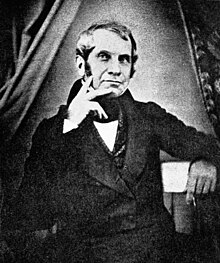Jacob Bigelow
Jacob Bigelow (born February 27, 1787 in Sudbury , Massachusetts , † January 10, 1879 in Boston ) was an American physician and botanist . Its botanical author abbreviation is " Bigelow ".
Life
Bigelow, the son of a farmer, studied at Harvard University , where he received a Bachelor of Arts degree and, after completing his medical degree , worked at the University of Pennsylvania in 1810 to obtain a doctorate in medicine.
He quickly became known as a botanist; he stood u. a. in contact with Sir James Edward Smith , Heinrich Adolf Schrader and Augustin Pyrame de Candolle . In 1812 he was elected to the American Academy of Arts and Sciences . Since 1818 he was an elected member of the American Philosophical Society . In 1820 he was one of the five people who were to design the American Pharmacopoeia , the first compilation of North American medicinal plants, and was a pioneer in establishing medical nomenclature in the English-speaking world.
Bigelow founded the first park cemetery in the United States, Mount Auburn Cemetery near Boston , which was to become the model for all other park cemeteries in the country and whose architectural elements were designed by Bigelow.
He worked at the Massachusetts General Hospital , where a bust commemorates him since 1856. From 1815 to 1855 he was professor of materia medica at Harvard University , and from 1816 to 1827 he held the Rumford professorship there. The Elements of Technology emerged from his lectures and was reprinted in two volumes in 1840 under the title Useful Arts considered in Connection With the Applications of Science .
For many years he was the President of the Massachusetts Medical Society, and from 1847 to 1863 he was the President of the American Academy of Arts and Sciences . He was particularly interested in the education of students. In addition to specialist books and articles, he also wrote poetry. His Florula Bostoniensis was the standard work on the flora of New England for three decades .
The American Medical Botany was the first book with color illustrations to appear in the USA, for which Bigelow developed his own aquatint process.
Bigelow was an ardent supporter of the technical utopian John A. Etzler and drew many ideas from his main work, Das Paradies .
Honors
In 1819 James Edward Smith named the plant genus Bigelovia from the olive family (Oleaceae) after him .
Works
- On the clavus or ergot of rye and other plants . In: The New England journal of medicine and surgery , V (1816), pp. 156-164 (digitized version )
- Florula Bostoniensis (1814; expanded editions 1824 and 1840)
- American Medical Botany, being a collection of the native medicinal plant of the United States. 3 volumes, Boston 1817–1820.
- Elements of Technology (1829)
- Nature in Disease (1854)
- Eolopoesis (1855)
- History of Mount Auburn (1860)
- On the Limits of Education (1865)
- A Brief Exposition of Rational Medicine (1867)
- The Paradies of Doctors, a Fable (1867)
- Modern Inquiries (1867)
- Remarks on Classical Studies (1867)
literature
- Axel W. Bauer : Bigelow, Jacob. In: Werner E. Gerabek , Bernhard D. Haage, Gundolf Keil , Wolfgang Wegner (eds.): Enzyklopädie Medizingeschichte. De Gruyter, Berlin / New York 2005, ISBN 3-11-015714-4 , p. 177.
Web links
- Author entry and list of the described plant names for Jacob Bigelow at the IPNI
- Jacob Bigelow (1787-1879) Papers. In: Library of the Gray Herbarium Archives. Harvard University, accessed January 13, 2016 .
- www.encyclopedia.com
- NNDB: Jacob Bigelow
Individual evidence
- ^ Member History: Jacob Bigelow. American Philosophical Society, accessed May 2, 2018 .
- ↑ Article “Technology” in the Encyclopédie de l'Agora
- ↑ Lotte Burkhardt: Directory of eponymous plant names . Extended Edition. Botanic Garden and Botanical Museum Berlin, Free University Berlin Berlin 2018. [1]
| personal data | |
|---|---|
| SURNAME | Bigelow, Jacob |
| BRIEF DESCRIPTION | American medic and botanist |
| DATE OF BIRTH | February 27, 1787 |
| PLACE OF BIRTH | Sudbury , Massachusetts |
| DATE OF DEATH | January 10, 1879 |
| Place of death | Boston |
